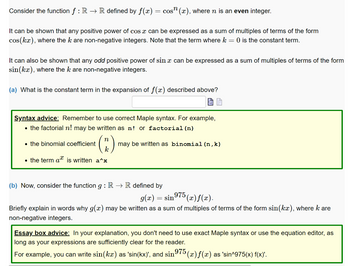
Advanced Engineering Mathematics
10th Edition
ISBN: 9780470458365
Author: Erwin Kreyszig
Publisher: Wiley, John & Sons, Incorporated
expand_more
expand_more
format_list_bulleted
Question

Transcribed Image Text:Consider the function f : R → R defined by f(x) cos(x), where n is an even integer.
It can be shown that any positive power of cos x can be expressed as a sum of multiples of terms of the form
cos(kx), where the k are non-negative integers. Note that the term where k = 0 is the constant term.
It can also be shown that any odd positive power of sin x can be expressed as a sum of multiples of terms of the form
sin(kx), where the k are non-negative integers.
(a) What is the constant term in the expansion of f(x) described above?
Syntax advice: Remember to use correct Maple syntax. For example,
• the factorial n! may be written as n! or factorial (n)
(2)
• the term a is written a^x
• the binomial coefficient
may be written as binomial (n,k)
(b) Now, consider the function g: R → R defined by
g(x) = sin
975 (x) f(x).
Briefly explain in words why g(x) may be written as a sum of multiples of terms of the form sin(kx), where k are
non-negative integers.
Essay box advice: In your explanation, you don't need to use exact Maple syntax or use the equation editor, as
long as your expressions are sufficiently clear for the reader.
975
For example, you can write sin(kx) as 'sin(kx)', and sin
'(x)f(x) as 'sin^975(x) f(x)'.
Expert Solution
This question has been solved!
Explore an expertly crafted, step-by-step solution for a thorough understanding of key concepts.
Step by stepSolved in 6 steps with 5 images

Knowledge Booster
Similar questions
- Prove the existence of a number x satisfying the expression cos(x) = = x.arrow_forward2) Find the EXACT value of cos if tan(0) = 3 and sin(0) < 0arrow_forwardSand is being dumped from a hopper railcar at a rate of 40 cubic feet per minute. It forms a pile in the shape of a right circular cone whose base diameter and height are always equal to each other (both are growing larger as more sand is dumped). How fast is the base diameter increasing when the base is 18 feet long? Round your answer to three decimal places. ft/minarrow_forward
Recommended textbooks for you
 Advanced Engineering MathematicsAdvanced MathISBN:9780470458365Author:Erwin KreyszigPublisher:Wiley, John & Sons, Incorporated
Advanced Engineering MathematicsAdvanced MathISBN:9780470458365Author:Erwin KreyszigPublisher:Wiley, John & Sons, Incorporated Numerical Methods for EngineersAdvanced MathISBN:9780073397924Author:Steven C. Chapra Dr., Raymond P. CanalePublisher:McGraw-Hill Education
Numerical Methods for EngineersAdvanced MathISBN:9780073397924Author:Steven C. Chapra Dr., Raymond P. CanalePublisher:McGraw-Hill Education Introductory Mathematics for Engineering Applicat...Advanced MathISBN:9781118141809Author:Nathan KlingbeilPublisher:WILEY
Introductory Mathematics for Engineering Applicat...Advanced MathISBN:9781118141809Author:Nathan KlingbeilPublisher:WILEY Mathematics For Machine TechnologyAdvanced MathISBN:9781337798310Author:Peterson, John.Publisher:Cengage Learning,
Mathematics For Machine TechnologyAdvanced MathISBN:9781337798310Author:Peterson, John.Publisher:Cengage Learning,


Advanced Engineering Mathematics
Advanced Math
ISBN:9780470458365
Author:Erwin Kreyszig
Publisher:Wiley, John & Sons, Incorporated

Numerical Methods for Engineers
Advanced Math
ISBN:9780073397924
Author:Steven C. Chapra Dr., Raymond P. Canale
Publisher:McGraw-Hill Education

Introductory Mathematics for Engineering Applicat...
Advanced Math
ISBN:9781118141809
Author:Nathan Klingbeil
Publisher:WILEY

Mathematics For Machine Technology
Advanced Math
ISBN:9781337798310
Author:Peterson, John.
Publisher:Cengage Learning,

